Team-BHP
(
https://www.team-bhp.com/forum/)
-
Motorbikes
(
https://www.team-bhp.com/forum/motorbikes/)
This is for those who are considering buying an Ather scooter.
For their scooters and chargers, Ather is using this connector:
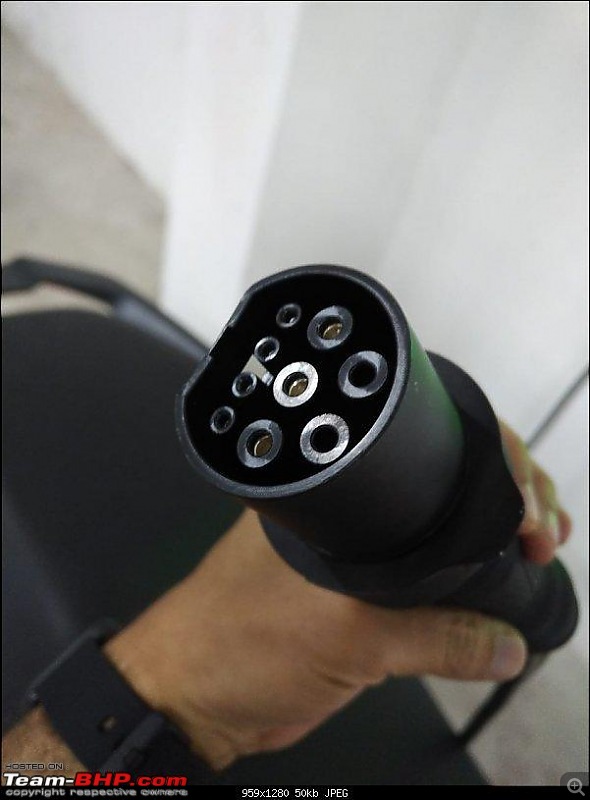
Source:
An 'e-motion'al connect - My Ather 450 Now ARAI has specified using CCS type 2 for DC fast charging:
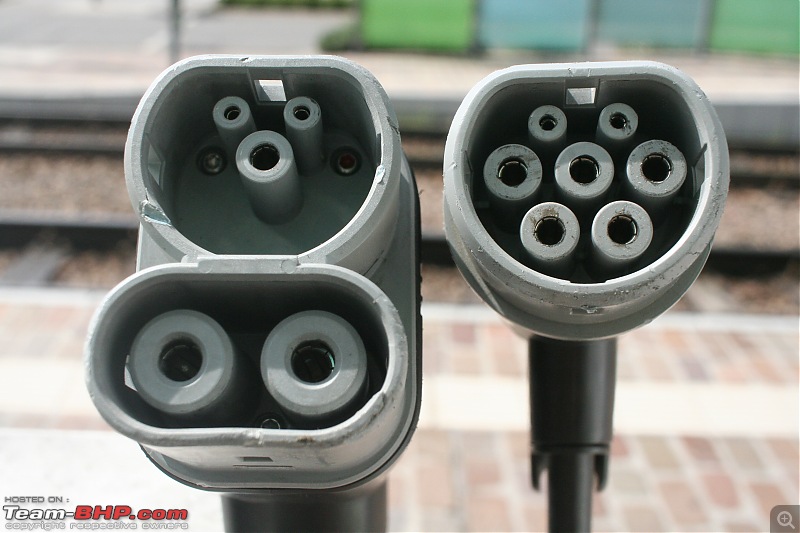
For more details, refer to AIS 138 part 2 here:
AIS 138 Part 2
And as you can see, Ather's charger won't go into a standard CCS port. For reference, here's CCS port on a Hyundai Kona which is expected to launch this year in India:

For further confirmation, I asked Ather about this and they have confirmed it:
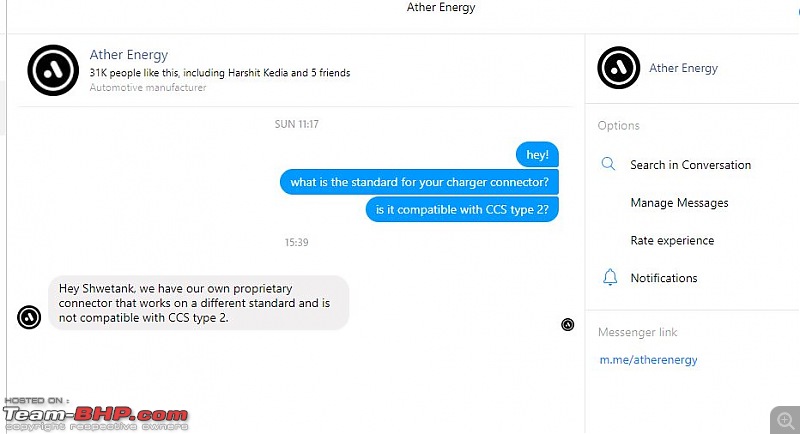 Hence, Ather owners won't be able to fast charge their scooters on public chargers and others won't be able to fast charge their vehicles on AtherGrid chargers.
Hence, Ather owners won't be able to fast charge their scooters on public chargers and others won't be able to fast charge their vehicles on AtherGrid chargers.
So if you are planning to buy an Ather scooter and buy any other electric vehicle (or a plug-in hybrid like Volvo XC 90), get ready to carry two chargers.
Now one might argue that Ather wants others to use their standard, however, that simply won't happen.
After all, EV manufacturers like Tesla, Volkswagen, Hyundai etc. and charger manufacturers like Seimens, Bosch, Exicom etc. have been making cars and chargers with ARAI specified CCS port for years now and won't be changing anything for a small company in India.
For comparison, I have an Apple iPad that uses lighting connector while My Android phone uses USB C-type charger. I cannot charge my iPad with my android charger and vice-versa. And as a result, I now carry two separate chargers :Frustrati
However, unlike Apple or Andriod chargers, chargers for electric cars can be super expensive. So be careful!
Moving out of Assembly line. Thanks for sharing - Support Team
Small things like these will matter in the long run. Households with multiple electric vehicles aren't unimaginable in the future, and it's in everyone's best interests (well, maybe not manufacturers) that a common standard is adopted, instead of everyone devising their own proprietary connectors.
Better do it now, or we'll have the same issue in the EV space that we have with personal electronics today.:)
Quote:
Originally Posted by LiCoO2
(Post 4577837)
So if you are planning to buy an Ather scooter and buy any other electric vehicle (or a plug-in hybrid like Volvo XC 90), get ready to carry two chargers.
Now one might argue that Ather wants others to use their standard, however, that simply won't happen.
|
Thanks for sharing. You have a valid point, this should have been an industry standard charging port. More than the plight of Ather owners (in fact, I doubt they would be affected), it makes sense as a very solid business case for Ather to treat their charging infrastructure separate from their scooters.
I'm reminded of how Amazon built the AWS cloud empire underneath their e-commerce site to support their ecosystem and branched it out to become a tech-giant. Ather can only benefit if the chargers are future proof and are able to support more vehicles, rather than being built and setup only to support their scooter system. They have the first mover advantage and can sell their network solution independently - for other companies to leverage as well.
That said, I doubt if Ather owners would need to worry -
1. We are talking about a city scooter here. Nothing more. At best, these chargers will only be used for a quick 10-20 kms range topup, not for full battery charger to resume interstate travel or anything. Even the Ather network is an overkill as such!
2. There is no other public charging infrastructure available on a wider scale. So these points on compatibility are more like suggestions for the future, rather than something currently gone wrong. Even Mahindra Reva doesnt have a setup after so many years.
3. Volvo XC90, Hyundai Kona, MG eZS, Tesla 3 - None of these would be an economically viable option likely to be purchased by an Ather owner. Mass adoption of EVs in India is still quite some time away.
Someone just has to make a converter or a male to female plug that is compatible one side with this unit and the other mates with your car or whatever. Its a non issue honestly, provided someone does it.
Think like the usb c to micro usb converters or vice versa available in the market.
On the other hand if the whole back end itself is unusable or incompatible, then it is quite stupid.
They could have done a fully compatible set up, rolled it out and charged other manufacturers for a subscription fee or license fee (like mobile tower infrastructure or ATMs). Great secondary source of revenue.
Quote:
Originally Posted by CrAzY dRiVeR
(Post 4577987)
Thanks for sharing. You have a valid point, this should have been an industry standard charging port. More than the plight of Ather owners (in fact, I doubt they would be affected), it makes sense as a very solid business case for Ather to treat their charging infrastructure separate from their scooters.
|
It is high time the industry gets its head together and defines a cross platform charger.
The same happened with mobile phones, where USB is now standard.
Quote:
Originally Posted by LiCoO2
(Post 4577837)
This is for those who are considering buying an Ather scooter.
For their scooters and chargers, Ather is using this connector:
After all, EV manufacturers like Tesla, Volkswagen, Hyundai etc. and charger manufacturers like Seimens, Bosch, Exicom etc. have been making cars and chargers with ARAI specified CCS port for years now and won't be changing anything for a small company in India.!
|
Sorry. IMO, its not a case of Ather forcing others to use their connector.
I believe the connector being used by Ather is Type 2 used in EU/ Australia. This is a standard connector and is used even by Mercedes (in their Smart B-class line-up; can vouch based on first-hand experience). Also even Tesla uses this connector for some markets (especially EU).
The other connector shown is a SAE combo type 2.
Even for countries that are ahead in the EV adoption, there are more than two standards available. Until the fast charging problem is solved, I guess we will see more of these change in standards :)
Quote:
Originally Posted by vinjosep
(Post 4578184)
Sorry. IMO, its not a case of Ather forcing others to use their connector.
I believe the connector being used by Ather is Type 2 used in EU/ Australia. This is a standard connector and is used even by Mercedes (in their Smart B-class line-up; can vouch based on first-hand experience). Also even Tesla uses this connector for some markets (especially EU).
The other connector shown is a SAE combo type 2.
Even for countries that are ahead in the EV adoption, there are more than two standards available. Until the fast charging problem is solved, I guess we will see more of these change in standards :)
|
This is not true. Their connector is a custom version of type 2 with 2 extra pins as shown in the pictures. Even Ather has confirmed that their connector is not compatible with type 2. And their connector is definitely not compatible with SAE type 2.
My take, this will go on for some time till real volumes pick and then industry moves to standardise them. See what happened in mobile industry, every phone manufacturer was on his own, simply because they wanted to cash in on the accessory revenue. But slowly the world moved to Micro USB and then Type-C.
I think some thing similar may happen here as well.
Of course there is also an angle of charging mechanism itself and current that can be pumped. But will keep that debate separate. Its similar to what we see in mobile industry as well.
These are teething troubles. The good news is other users abroad have already faced this issue and they have found a solution. Here is a type 1 to type 2 converter. Just ask someone abroad to get it for you, or convince Ather to give you this as an accessory.
CONVERTER
Quote:
Originally Posted by LiCoO2
(Post 4578186)
This is not true. There connector is a custom version of type 2 with 2 extra pins as shown in the pictures.
Even Ather has confirmed that there connector is not compatible with type 2. And There connector is definitely not compatible with SAE type 2.
|
Quote:
Originally Posted by Iyencar
(Post 4578448)
These are teething troubles. The good news is other users abroad have already faced this issue and they have found a solution. Here is a type 1 to type 2 converter. Just ask someone abroad to get it for you, or convince Ather to give you this as an accessory. CONVERTER
|
Converters won't work because they are designed only for standard connectors. Ather has customised their connector.
This is to the detriment of Ather users since they won't be able to use public fast chargers. But technology and market penetration are fast changing so it's hard to predict the situation in a couple of years.
I agree with the overall sentiment behind this thread that we should have a standard interface for all EVs. But as
ampere has written, after EV volumes increase, the industry will move to standardise connectors similar to smart phone industry (where Apple still wants to be different :Frustrati).
However I don't understand why you make it sound like a scam! especially the comment below
Quote:
However, unlike Apple or Andriod chargers, chargers for electric cars can be super expensive. So be careful!
|
It is something to be aware of not to be careful of IMO. I hope you meant to say the former and not the latter.
Going into details, I'll have to disagree with some comments
Quote:
Originally Posted by LiCoO2
(Post 4577837)
This is for those who are considering buying an Ather scooter.
For their scooters and chargers, Ather is using this connector: Attachment 1869957
Source: An 'e-motion'al connect - My Ather 450 Now ARAI has specified using CCS type 2 for DC fast charging: Attachment 1869958
For more details, refer to AIS 138 part 2 here: AIS 138 Part 2
And as you can see, Ather's charger won't go into a standard CCS port. For reference, here's CCS port on a Hyundai Kona which is expected to launch this year in India: Attachment 1869955
For further confirmation, I asked Ather about this and they have confirmed it: Attachment 1869953
|
ARAI's reference to the IEC 60309, IEC 60884 and IEC 62196 is not a mandatory requirement but just a guideline IMO. If it was a mandatory requirement, Ather's scooters wouldn't have passed homologation and they couldn't have sold the vehicle. Forget Ather, none of the Electric scooters use the CCS plug you've shown. Okinawa, Hero electric, all have different plugs. Even in cars, not all come with the CCS plug.
Quote:
Hence, Ather owners won't be able to fast charge their scooters on public chargers
|
1. What public chargers are you talking about? Mahindra's public chargers have their own proprietary plugs, BESCOM or any other electric supply companies have their own.
2. Wherever there is a domestic 5A plug, Athers can be charged with the optional cable. Also it is just a city scooter. Also it is a recorded that more than 95% of Ather's charging is done at home.
Quote:
and others won't be able to fast charge their vehicles on AtherGrid chargers.
|
AtherGrid chargers have 5A/15A socket and any EV can be charged there (using it's own respective cable of course). I've charged my E2O there.
Quote:
So if you are planning to buy an Ather scooter and buy any other electric vehicle (or a plug-in hybrid like Volvo XC 90), get ready to carry two chargers.
|
Definitely a possibility in future Indian automotive scene. Having 2 EVs in my own garage I can say that this is not a big worry but I'd love to have a standard one. If you visit the Tesla website, they have recommended to have home charger installed (with their fast charging Menneke's plug) and a portable cable as "backup" when on road. Carrying a vehicle charger in the vehicle is hardly inconvenient compared to carrying a charger for a phone.
Quote:
After all, EV manufacturers like Tesla, Volkswagen, Hyundai etc. and charger manufacturers like Seimens, Bosch, Exicom etc. have been making cars and chargers with ARAI specified CCS port for years now and won't be changing anything for a small company in India.
|
No, everyone is not using CCS ports. Teslas use a modified version of the the Type 2 in US and in Europe it comes with CCS plug. Nissan leaf has dual ports- CHAdeMO and Type 1. Volvo XC90 uses the standard Type 2 plug.
Locally Mahindra uses different ones. they are so different that different versions of E2O has different chargers!!!
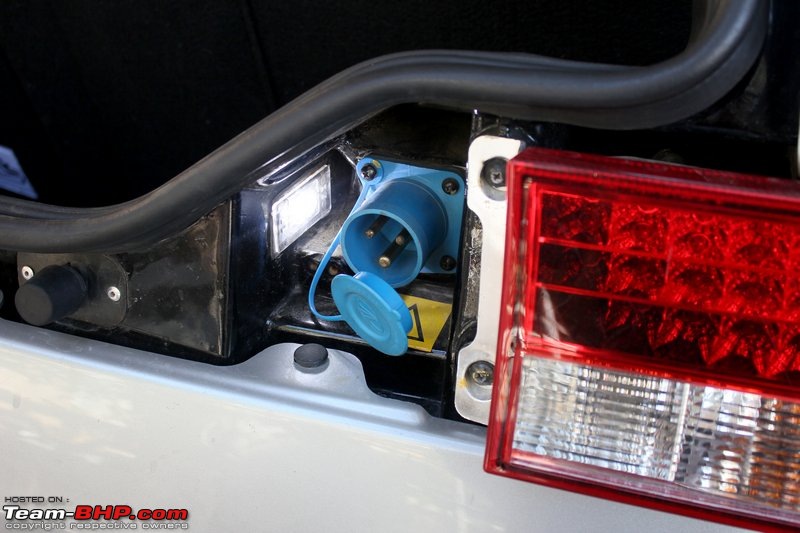
The charging plug on E2O reviewed by TBHP. This is the same plug that we have on our E2O Plus. This is not any standard plug.
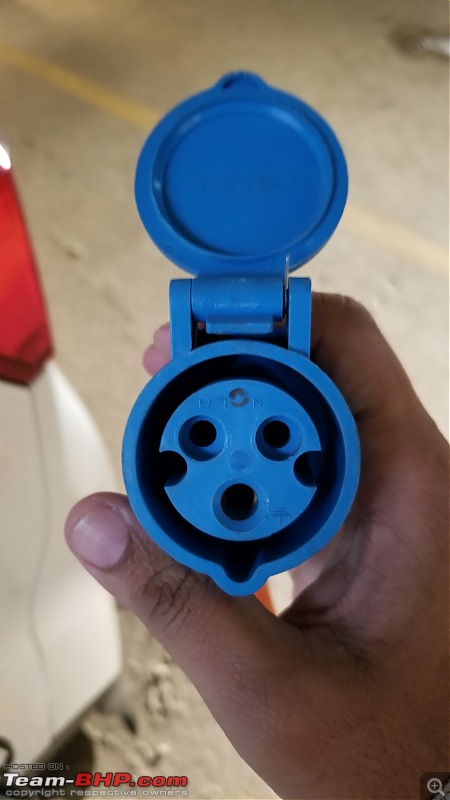
The corresponding socket on the cable.
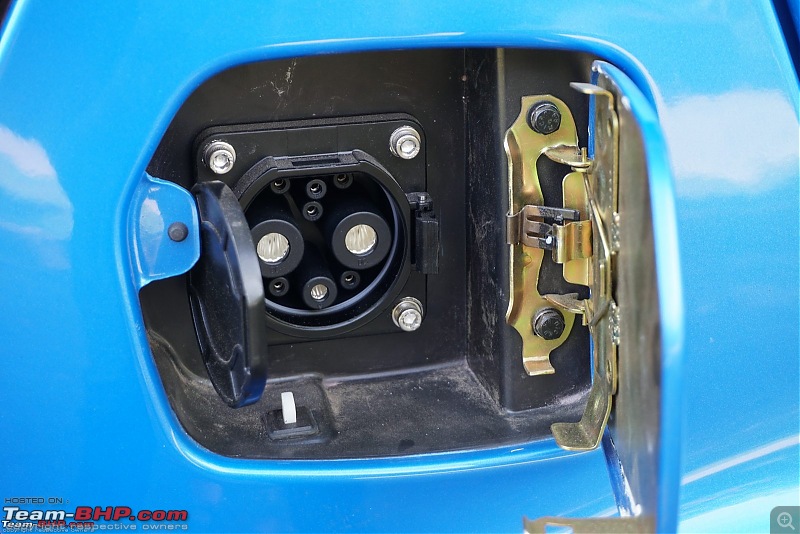
The plug on the E20 Plus that was reviewed by TBHP was different! Here is the slow charging plug (another non standard design)

The other plug (fast charging) on the same car... This is Type 2 and available only on 2 variants
Revai had a different on IIRC.
Quote:
For comparison, I have an Apple iPad that uses lighting connector while My Android phone uses USB C-type charger. I cannot charge my iPad with my android charger and vice-versa. And as a result, I now carry two separate chargers :Frustrati
|
I carry an iphone6 and a Samsung Note but have only one charger...Qi. So the day is not far away when we have wireless charging for all phones and who knows, we might have wireless charging for all EVs too!
Quote:
Originally Posted by hemanth.anand
(Post 4578549)
Forget Ather, none of the Electric scooters use the CCS plug you've shown. Okinawa, Hero electric, all have different plugs
|
This is because they don't need it. Their battery capacity is so low that they can simply use the existing 3 pin socket. They don't need any specificlised EV charging station.
Quote:
Originally Posted by hemanth.anand
(Post 4578549)
What public chargers are you talking about? Mahindra's public chargers have their own proprietary plugs, BESCOM or any other electric supply companies have their own.
|
This is not true. Mahindra is using GB/T connector which is the Chinese standard for fast DC charging. This is an acceptable charging standard by ARAI. It's called Bharat DC-001. It is only for DC charging less than 15 kW.
Here's a document showing that:

The 3 pin connector that you are showing is for AC slow charging.ARAI has defined that too.
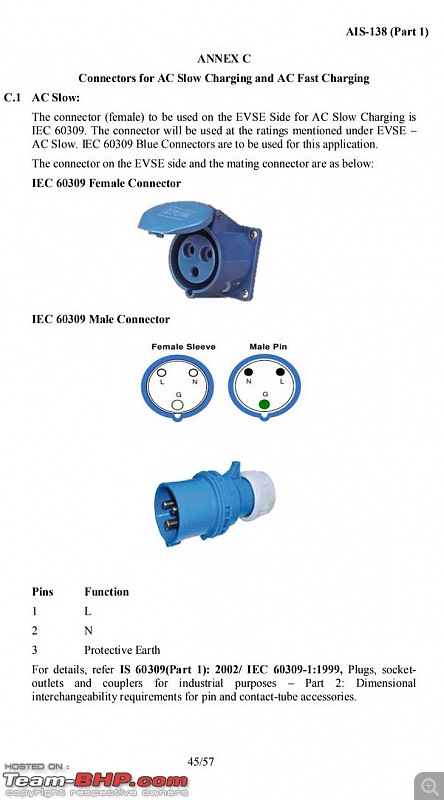
Hence, All the standards used by Mahindra are following ARAI's standard.
Quote:
Originally Posted by hemanth.anand
(Post 4578549)
No, everyone is not using CCS ports. Teslas use a modified version of the Type 2 in US and in Europe it comes with CCS plug. Nissan leaf has dual ports- CHAdeMO and Type 1. Volvo XC90 uses the standard Type 2 plug
|
You are absolutely correct about this. However, when Tesla and Nissan's leaf came out, CCS combo didn't even exist. Hence, Tesla created there own while Nissan leaf used Chademo, a standard developed by the Japanese company Telco.
The entire industry is now moving towards CCS combo right now. As far as I know, only Nissan Leaf offers CHademo while everyone else has shifted to CCS combo in Europe for new vehicles. And I don't see any reason why we shouldn't standardise this right from the beginning in our country.No point in repeating other's mistake.
As far as wireless charging goes, no common standard exists for EVs and none of them has gone into production. It's also really inefficient for EVs due to very high power involved .
Quote:
Originally Posted by hemanth.anand
(Post 4578549)
therGrid chargers have 5A/15A socket and any EV can be charged there (using it's own respective cable of course). I've charged my E2O there.
|
How long does it take for your E2O to get charged with AtherGrid? I am guessing it takes 5 hours to 3 hours, right?
I don't believe that practical for public fast charging.
Here's an E2O being fast charged:
https://www.youtube.com/watch?v=7mj_-wzjHLM&t=512s
Note: The video says its Chademo but its actually GB/T.
I'm not an expert with such systems but this type of incompatibility has always existed. For a fact that we use 3 pin sockets while US or Germany uses only 2 pins. Not to forget the 110 v and 230 v mains. It's only a matter of time until adaptors come out.
The pin diagrams are already there and all that is needed is some tech geek to figure it out.
Quote:
Originally Posted by LiCoO2
(Post 4578587)
This is because they don't need it. Their battery capacity is so low that they can simply use the existing 3 pin socket. They don't need any specificlised EV charging station.
This is not true. Mahindra is using GB/T connector which is the Chinese standard for fast DC charging. This is an acceptable charging standard by ARAI. It's called Bharat DC-001. It is only for DC charging less than 15 kW.
The 3 pin connector that you are showing is for AC slow charging. ARAI has defined that too.
You are absolutely correct about this. However, when Tesla and Nissan's leaf came out, CCS combo didn't even exist. Hence, Tesla created there own while Nissan leaf used Chademo, a standard developed by the Japanese company Telco.
|
Does a vehicle need the CCS or not; Mahindra following a Chinese standard; Nissan and Tesla coming before CCS...whatever may be the points, the crux of the matter is there are many different interfaces and Ather's interface is another addition to that. The fact that Ather is able to sell scooters shows that ARAI has approved it's connector
Quote:
The entire industry is now moving towards CCS combo right now. As far as I know, only Nissan Leaf offers CHademo while everyone else has shifted to CCS combo in Europe for new vehicles. And I don't see any reason why we shouldn't standardise this right from the beginning in our country.No point in repeating other's mistake.
|
In Europe yes, but not in other countries and certainly not in India at least. And there is no guarantee that CCS is here to stay.
Quote:
As far as wireless charging goes, no common standard exists for EVs and none of them has gone into production. It's also really inefficient for EVs due to very high power involved .
|
Agreed. But, who knows? the pace at which things will change in this area, wireless charging days may not be too far. Something totally new may also come by.
Quote:
How long does it take for your E2O to get charged with AtherGrid? I am guessing it takes 5 hours to 3 hours, right?
I don't believe that practical for public fast charging.
|
My E20 Plus is P6 variant which has only one AC slow charging plug. It takes the same time wherever I charge it (around 5 hours). Couple of times, when I had to watch a movie, I have taken it to a Mall with charging facilities. By the time I finish watching a movie I have full charge. AtherGrid is also placed in places where there is something to do (like cafes and malls)
Important to remember is Public charging places are best used for top-up and not for 0-100% charging
All in all, I do not understand why I should be worried or concerned (I'll not use the word careful) so much that my Ather's connector is different to my E2O or any other EV? As long as I have the backup cable, the connector interface should not be a deal breaker at all!
| All times are GMT +5.5. The time now is 07:28. | |











